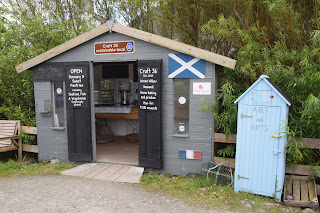Our
plans to meet Sue and Martin on their canal boat, were thwarted as the drought resulted in the Oxford
canal running out of water. The quickly developed alternative, was a day trip to
London.
In
years gone by Helen and I, when passing on the train, regularly joked about how
many bricks were in Battersea power station. In the ‘70’s it was a rundown industrial area. Not so today where it is the latest competition to Canary
Wharf. The power plant has been converted to a stunning array of flats and the
surrounds have also be completely rejuvinated with many new unit blocks. Shops are opening and the place
is a hub of activity. The new underground station and wharf have also helped.
Although it melds well with
the surrounding buildings with its bright white chimneys, from the river it still cuts a very imposing building.
We took the Uber ferry downstream (thanks to the tide it was against the flow) and passed the old London to Chatham and Dover railway bridge (1862) over which we travelled when we saw Battersea. The bridge was demolished in the 1980s as it was not deemed safe enough for modern railway stock. The piers have been left intact as there were fears their removal could endanger the footings of the adjacent Blackfriars bridge.
The
piers are a stunning monument which are advertised at the end abutment with a
striking refurbished insignia of the line.
Our walk was directed towards the nearby refurbished OXO
building which has a great view from its rooftop restaurant. A long lunch helped
in taking in the views.
The first was a section of the enormous
Tideway project. It is a new 25 km long 7.2 metre diameter sewer system. It is
huge! It will protect the Thames for the next 100 years from inadvertent sewage
release and cater for the anticipated population doubling between now and 2060 (8.8M to 16M).
The Victoria embankment foreshore
was opposite our lunch spot and is one of 24 locations where access to the (now
completed) tunnels will occur. All is on track for completion in 2025.
Of course, no trip in this area
would be complete without a shot of the London Eye. Given it was a Millenium project and due to be removed after the first year or so it has been very profitable. It has also resulted in major
improvements to what was a rundown area and despite the £36 ticket price is still pretty popular.
It is still the largest cantilevered cable observation wheel in Europe.
Opposite is the much older structure of Westminster (1837 - 1860). It is imposing on a couple of levels. It has recently gone through a large refurbishment and the sandstone now really glows in the light.
I particularly wanted to see the clocktower
which is the face of Big Ben. Most of my life it has been black hands and
numerals. During refurbishment, they peeled back the paint and found the original
was Prussian Blue. This has now been reinstated. It really works against the blond
stonework with the real gold finishes glistening in the sun. (Real gold is used
as it lasts longer than paint. Theft at that height and visibility would appear
unlikely!)
Although this is a blog on London you will probably have noticed the engineering theme. With that in mind I had to include Westminster underground. This was rebuilt as part of the Jubilee line in 1999. It is a solid engineering infrastructure which looks great. Who needs architects? I am sure they played their part but either way the result is stunning. Every view is different – it makes riding the escalator much more interesting than the conventional enclosed tube.
































































